Removing
1. Disconnect the negative cable from the battery.
2. Remove the air cleaner assembly from the carburetor.
3. Disconnect the fuel supply hose from the carburetor and plug it to prevent dirt from entering the fuel system.
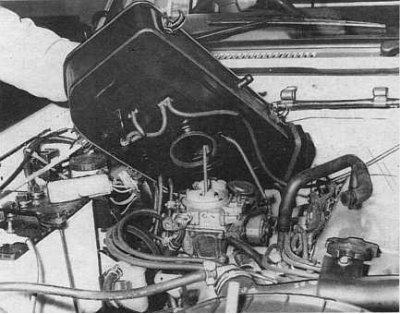
4. Mark and disconnect vacuum hoses from the carburetor (the accompanying illustration shows the air cleaner raised to show the vacuum connections (engine 4.2 l)).
5. Disconnect the carburetor electrical connectors.
6. Using the drive lever, move the throttle valve to the fully open position and, using the resulting slack in the drive cable, disconnect the latter from the throttle valve lever.
7. Give nuts of fastening of the carburettor on the inlet pipeline, remove washers. Remove the carburetor with gasket. Throw away the pad.
8. On 3.0L models, disconnect the electrical connector and remove the heater.
9. Seal the intake manifold inlet with a clean, lint-free rag to prevent foreign objects from entering the engine.
Installation
Installation is in the reverse order.
1. Be sure to install a new gasket between the carburetor and intake manifold. If necessary, first carefully remove traces of the old one from the mating surfaces, making sure that debris does not fall into the inlet pipeline.
2. Check the carburetor for signs of fuel leaks and loss of vacuum. After the engine warms up, adjust the idle speed.
Disassembly
External view of the 4.2L engine carburetor showing the location of various components (side view and top view - carburetor model with manual transmission)
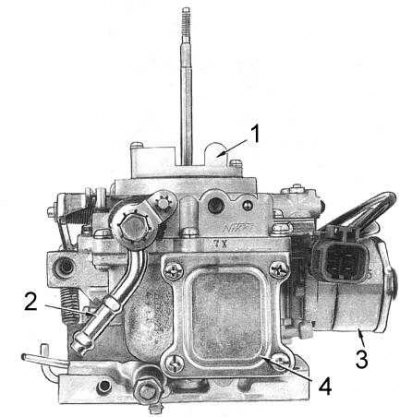
1 - air ventilation; 2 - fuel inlet pipe; 3 - assembly of the device for controlling the quality of the mixture during deceleration (BCDD); 4 - side cover
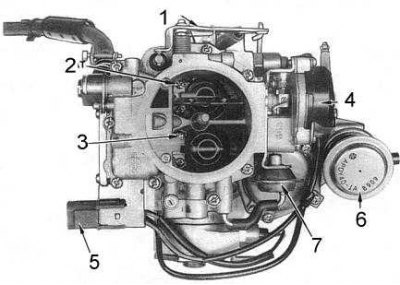
1 —- the accelerator pump drive lever; 2 - primary diffuser; 3 - secondary diffuser; 4 - start automatic device; 5 - electrical connector; 6 - actuator for fast idle; 7 —- choke opening automatic start
When performing a major overhaul of the carburetor, attention should be paid to the following points:
- All components must be thoroughly rinsed in a suitable solvent and checked for signs of wear and damage;
Note. Do not immerse solenoid assemblies and components with vacuum diaphragms in solvent
- Try to stack all components removed from the carburetor separately and with reference to their position in the assembly;
- To clean the various jets, throttles and channels, use only compressed air. Under no circumstances should the blockage be removed with a wire or other kind of probes!
- When performing a major overhaul of the carburetor, use special gasket repair kits and without fail replace all removed diaphragms and o-rings. Also replace any worn components.
- To avoid damage to jets and screw heads, use screwdrivers and wrenches of the correct size when removing/installing them.
1. Remove the carburetor from the vehicle.
2. Disconnect the throttle return springs from the accelerator pump drive lever.
3. Remove the E-clamp and the washer that secures the accelerator pump drive lever to the top cover of the carburetor (the main components of the carburetor are shown in the accompanying illustration).
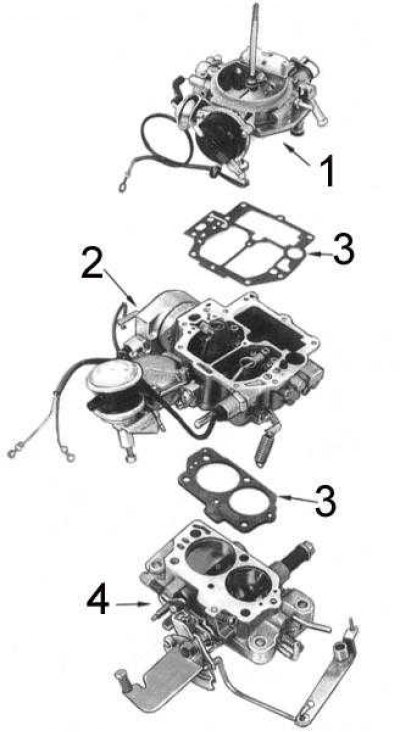
1 - top cover; 2 - main building; 3 - gasket; 4 - throttle body
4. Remove the fast idle cam E-clamp, then while holding the cam, disconnect the return spring.
5. Release the lock on each of the wires in the carburetor electrical connector. Try to remember the position of the wires in the connector.
6. Disconnect the automatic air damper return spring from the automation assembly.
7. Give fixing screws and partially separate the top cover from the main case of the carburetor. Disconnect the air damper drive lever from the axis of rotation of the latter.
8. Remove the top cover with gasket from the main body of the carburetor.
9. Remove the accelerator pump spring from the main body.
10. If one is installed, remove the reduction tube of the plastic flow meter located above the idle jet II.
11. Turn the main body upside down and remove the E-clip and throttle diaphragm actuator linkage II.
12. Give fixing screws in the bottom part of the case of throttles. Note the location of the hollow screw.
13. Remove the main body with gasket from the throttle body. Remove the insulator from the body.
14. Now the carburetor will be disassembled into three main components - the top cover, the main body and the throttle body.
15. Maintenance of carburettor top cap assemblies
16. Remove the fuel inlet hollow bolt retainer plate.
17. Turn out a hollow bolt, remove a tube of an inlet of fuel, washers and the filter. Check the condition of the filter, clean or replace if necessary.
18. Remove the plunger assembly of the accelerator pump. Check the plunger for signs of wear and damage. Replace plunger if necessary.
19. In the case of an appropriate configuration, give the fixing screws and remove the plastic ventilation assembly with the gasket from the top cover.
20. Using pliers, remove the float pin from the top cover, then remove the float, needle valve.
21. Using a screwdriver, remove the needle valve seat with washer from the top cover.
22. Remove the spring clip securing the needle to the float. Check needle valve components for signs of wear, replace defective ones.
23. Check the top cover for cracks or other damage. Check that the automatic start choke moves freely, without jerks or sticking points.
24. On 3.0L models, check that the hot idle leaner bimetal plate is not broken or otherwise damaged.
25. Reassemble in reverse order.
Maintenance of carburetor top cover assemblies
1. Remove the stop plate of the fuel inlet hollow bolt (carburetor top cap components are shown in the accompanying illustration).
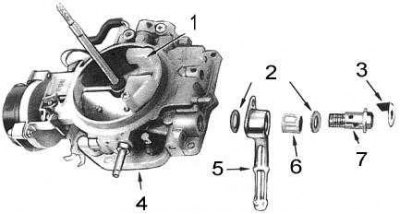
1 - ventilation assembly; 2 - washers; 3 - locking plate; 4 - top cover; 5 - tube; 6 - filter; 7 - hollow bolt
2. Turn out a hollow bolt, remove a tube of an inlet of fuel, washers and the filter. Check the condition of the filter, clean or replace if necessary.
3. Remove the plunger assembly of the accelerator pump. Check the plunger for signs of wear and damage. Replace plunger if necessary.
4. In the case of an appropriate configuration, give the fixing screws and remove the plastic ventilation assembly with the gasket from the top cover.
5. Using pliers, remove the float pin from the top cover, then remove the float, needle valve.
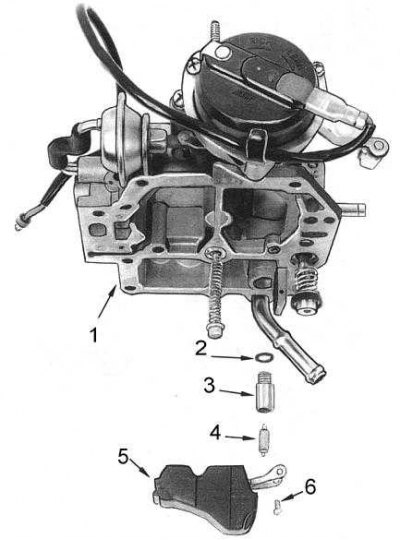
1 - top cover; 2 - washer; 3 - needle valve seat; 4 - float; 5 - needle; 6 - axle pin
6. Using a screwdriver, remove the needle valve seat with washer from the top cover.
7. Remove the spring clip securing the needle to the float. Check needle valve components for signs of wear, replace defective ones.
8. Check the top cover for cracks or other damage. Check that the automatic start choke moves freely, without jerks or sticking points.
9. On 3.0L models, check that the warm idle leaner bimetal plate is not broken or otherwise damaged.
10. Reassemble in reverse order.
Maintenance of main building units
1. Remove the solenoid shut-off valve with washer from the main body. Using a 12 V battery, check the proper operation of the valve by pressing it against the negative terminal of the battery, and connecting the wire to the positive. The valve plunger should then retract. Replace valve if necessary.
2. If equipped, remove the mixture control solenoid valve during deceleration (BCDD) with washer from BCDD assembly.
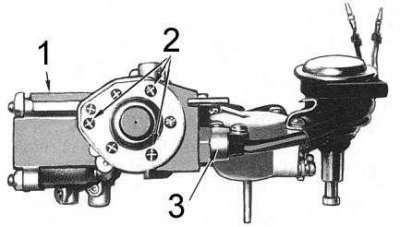
1 - main building; 2 - screws for fastening the BCDD assembly; 3 - electromagnet
3. Loosen the mounting screws and remove the BCDD assembly from the main carburetor body.
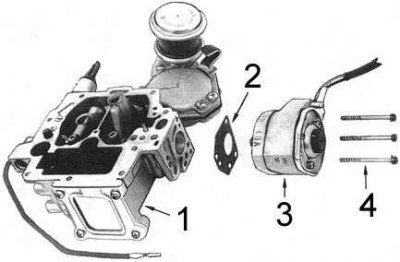
1 - main building; 2 - gasket; 3 - BCDD assembly; 4 - screws
4. Loosen the fixing screws and remove the side cover of the fuel chamber, gasket, plug plate from the main body (or sight glass) and sealant (see accompanying illustration).
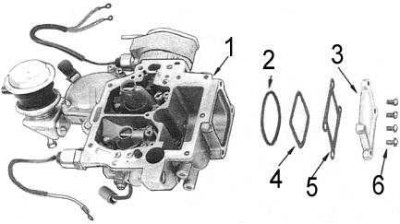
1 - main building; 2 - sealant; 3 - cover; 4 - plate; 5 - gasket; 6 - screws
5. At the corresponding complete set give fixing screws and remove the damper of fast idling.
6. Give fixing screws and remove throttle valve assembly II from the main body.
7. Remove the spring clip from the accelerator pump plunger well. Turn the main body upside down and remove the mesh screen and ball (see accompanying illustration).
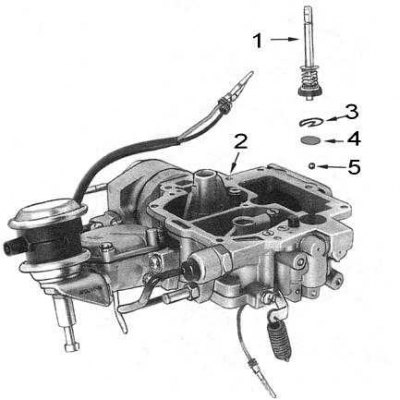
1 - plunger; 2 - main building; 3 - clamp; 4 - mesh screen; 5 - ball
8. Remove the accelerator pump discharge weight fixing plug, turn the main body over and remove the weight, spring and ball (see accompanying illustration).
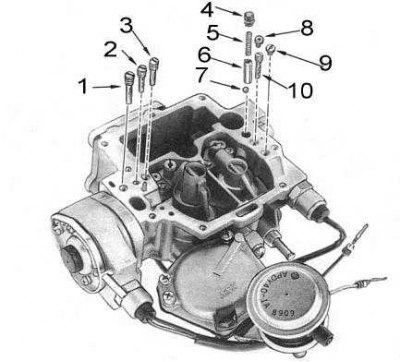
1 - idle air jet II; 2 - idle fuel jet II; 3 - plug; 4 - cork; 5 - spring; 6 - weight; 7 - ball; 8 - screw; 9 - idle air jet I; 10 - idle fuel jet I
9. Remove the main air jets. Loosen the fixing screws and remove the atomizers from the main body. The removed components are shown in the accompanying illustration.

1 - main air jets with emulsion tubes; 2 - screws; 3 - atomizer; 4 - gaskets; 5 - main building
10. Remove the remaining jets from the main body.

1 - economizer jet; 2 - main fuel jet I; 3 - main fuel jet II; 4 - main building
Note. It is important that the jets are installed correctly during assembly. Otherwise, problems with the functioning of the engine will inevitably arise. If necessary, refer to the dimensional characteristics of the jets (see tables of sizes and adjustments at the end of the guide).
11. Thoroughly wash each jet in a suitable solvent, then blow it out with compressed air.
Attention! To avoid damage, never attempt to clean the jets with wire or thin drills.
12. Thoroughly wash the main body of the carburetor with solvent and dry it with compressed air.
13. Using a manual vacuum pump, check the condition of the throttle diaphragm II. Replace defective components.
Servicing throttle body assemblies
Note. Due to the tolerances adopted by manufacturers, the probability of correctly reproducing the fit of the throttle valve axes in the throttle body is negligible. For this reason, if the axles are damaged, the throttle body assembly must be replaced.
1. On models with AT, give the fixing bolts and remove the throttle sensor-switch from the throttle body.
2. Wash the throttle body in a suitable solvent and dry it with compressed air.
3. Check the throttle actuator rods for signs of jamming, lubricate the actuator if necessary.
4. On models with AT, install the throttle valve sensor-switch in its place on the throttle body, then adjust it.
Carburetor assembly
Assembly is carried out in the reverse order of dismantling.
1. Using new gaskets, connect the throttle body to the main carburetor body. Tighten the mounting bolts securely. Make sure that the hollow screw is screwed into its original place in the throttle body (see accompanying illustration).

1 - hollow screw
2 - throttle valves
2. Install the throttle diaphragm II and secure it with the E-clip.
3. Install the accelerator pump plunger assembly from your well. Be sure to replace the carburetor top cover gasket.
4. Install the top cover on the main body and connect the air damper lever to the main body's pivot shaft. Tighten the fixing screws firmly.
5. Install the fast idle cam with spring, put the E-clip on the axle.
6. Establish the axial plug of the lever of a drive of the accelerating pump and connect the lever to an axis. Place the E-clip on the axle and connect the throttle return springs.
7. Connect the throttle return spring II to the automatic start assembly.
8. Connect the wires to the carburetor electrical connector, each in its original place.
9. Install the carburetor to the intake manifold.
10. If necessary, adjust idle speed and fast idle speed.
Checks and adjustments
Adjusting the fuel level setting in the float
Note. On some models, the carburetor is equipped with a special viewing window. If the fuel level in the sight glass was normal before removal and disassembly of the carburetor, and the needle and needle valve seat were not replaced during the maintenance procedures, no additional adjustment is required.
1. Remove the top cover with gasket from the carburetor.
2. Turn the top cover over so that the float seat tab rests on the needle valve.

3. Measure distance A (see accompanying illustration) from the top of the float to the gasket surface of the carburetor top cap. On 4.2 l models it should be 9.5÷10.5 mm, on 3.0 l models it should be 5.0÷6.0 mm.
4. If adjustment is necessary, gently bend the float seat tab to the desired value. Make sure that the needle valve slides smoothly over the float tongue.
5. Flip the top cover back to its normal position, allowing the stop tab of the float to come into contact with the stop.
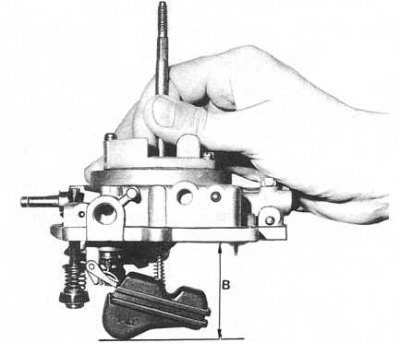
6. Measure distance B (see accompanying illustration) from the gasket surface of the top cap of the carburetor to the bottom of the float. On 4.2 l models, the result should be 47.5÷48.5 mm, on 3.0 l models - 44.0÷45.0 mm.
7. Gently bend the locking tab to make adjustments.
8. Install the top cap on the carburetor, start the engine and check for vacuum losses and fuel leaks.
Fast idle speed adjustment without removing the carburetor from the engine
1. Start the engine and warm it up to normal operating temperature. Connect a tachometer and set the idle speed and mixture according to the manufacturers instructions. Stop the engine.
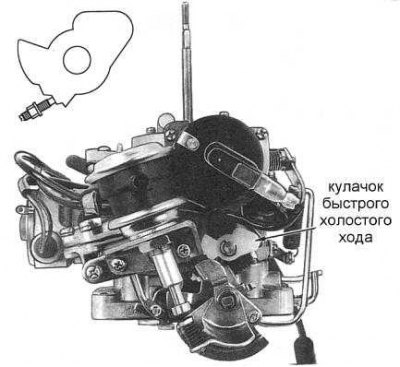
2. Open the throttle and set the adjusting screw to the second stage of the fast idle cam (see accompanying illustration - the insert shows the screw mounted on the second stage of the cam).
3. Without touching the gas pedal, start the engine and compare the tachometer readings with regulatory requirements (see tables of sizes and adjustments at the end of the guide).
4. If adjustment is necessary, loosen the fast idle adjusting screw locknut and turn the screw until the desired reading is reached.
Fast idle speed adjustment on a carburetor removed from the engine
1. Open the throttle and set the adjusting screw to the second stage of the fast idle cam.
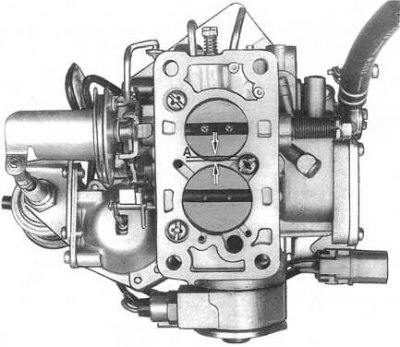
2. Measure gap A (see accompanying illustration) between throttle valve I and the inner wall of the carburettor. Compare the measurement result with the data tables of sizes and adjustments.
3. To make adjustments, loosen the fast idle adjusting screw locknut and turn the screw until the desired reading is reached.
Adjustment of the vacuum actuator for slightly opening the air damper
1. Make sure the choke is fully closed when the engine is cold.
2. Apply vacuum to the choke opener and lightly push the piston rod towards the choke diaphragm.
3. Measure the gap between the edge of the air damper and the inner wall of the primary chamber. Compare the result with the requirements tables of sizes and adjustments.
4. To make adjustments, slightly bend the rod on the axle.
Throttle damper adjustment
1. Start the engine and warm it up to normal operating temperature. Connect a tachometer and set the speed to the quality of the idle mixture.
2. Open the throttle and check the engine speed with the damper in contact with the adjusting screw. Compare the measurement result with the requirements tables of sizes and adjustments.
3. If adjustments are necessary, turn the adjusting screw at the end of the damper shaft in the desired direction and repeat the check of the previous paragraph.
4. Make sure the rpm drops smoothly from 2,000 to 1,000 per minute in about three seconds.
Adjusting the idle speed with the air conditioner on
1. Start the engine and warm it up to normal operating temperature. Connect a tachometer and set the speed to the quality of the idle mixture.
2. Turn on the air conditioner and check the idle speed. Compare result with data tables of sizes and adjustments.
3. To perform adjustments on models with AT and 3.0 l, turn the adjusting screw on the end of the damper in the appropriate direction. On 4.2L models with manual transmission, adjustment is made by turning the screw at the end of the throttle shaft.
Adjustment of turns and quality of a mix of idling
The procedure is described in detail in Chapter Settings and ongoing maintenance.
Checking the functioning of the automatic start
1. With a cold engine, fully open the throttle and make sure the choke is closed. Make sure that the alignment marks on the cover of the starting automation and the carburetor body are aligned.
Note. If the air damper will not close, check its axle for signs of jamming.
2. Start the engine and warm it up to normal operating temperature. Make sure the air damper is fully open.
3. If the shutter is not fully open, connect a test lamp between the wire on the starter power housing and the nearest reliable ground point. If there is no current (the lamp is off), check the condition of the relay and wiring of the automatic start.
Check of serviceability of functioning of the electromagnetic shut-off valve
1. Disconnect the carburetor electrical connector.
2. Apply battery voltage to the terminals shown in the accompanying illustration (at). When applying and disconnecting power, a click of the valve operation should be clearly audible.
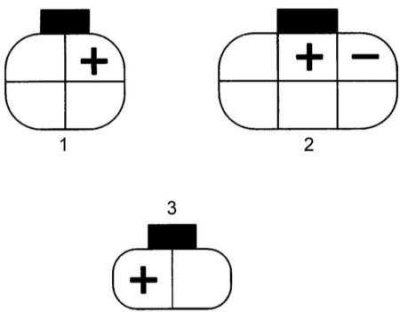
1 - 4.2 l manual transmission
2 - 3.0 l
3 - 4.2 l AT
3. Otherwise, replace the valve.
Throttle switch adjustment (only models with AT)
1. Check up correctness of installation of turns of idling on the engine warmed up to normal working temperature. Stop the engine.
2. Disconnect the wiring from the throttle switch and throttle position sensor.
3. Start the engine and check the idle speed at "N" selector lever.
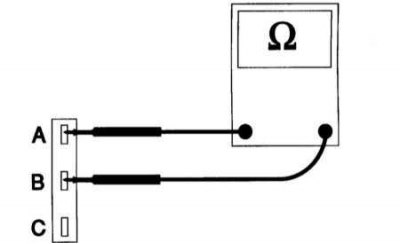
4. Check for continuity between terminals A and B (see accompanying illustration).
5. Make sure that the contacts of the sensor-switch open when the idle speed is exceeded by 250±150 rpm in the transmission position "N".
6. If there is a need for adjustment, loosen the bolts of the sensor-switch and rotate the latter to open the contacts at the right time (at the specified speed).
7. Tighten the sensor-switch mounting bolts and check for correct adjustment.
8. Connect the wiring to the throttle switch and throttle position sensor.